Achievements, problems and prospects of the pilot phase
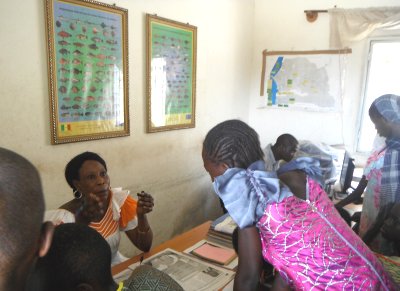
Like other institutions involved in the project, the Mountain 1 School in Hann carried out activities both in class and during field trips. The school preferred to spend the limited time before the school holidays for preparatory exercises during the following subjects: observational sciences, French and awakening, as well as during field trips. In fact, the teacher leading the project within this institution, Mr. Mamadou Ndiaye, together with the second teacher, Mr. Ndiaye Sall, prefers to wait for the resumption of classes in September-October 2012, to develop a theatre piece. They intend to integrate the five key principles of the ecosystem approach to fisheries (EAF) in this piece. They are indeed inspired by the experience of the Khadim School, which has keenly exploited the five key principles in a sketch, which made them win the school theatre contest of the Academic Department in Dakar.
The teachers at this institution took an innovative initiative before entering the exercises themselves. They collected data from various departments of the municipality to make a presentation of the various activities that support the municipal budget and thereby enable students to appreciate the importance of fishing for local development. Regarding the exercises themselves, they focused on (i) pencil drawings, (ii) reports on observation and (iii) the argumentative texts in French lessons. All exercises were performed according to a three-step process.
In-class exercises and outside observations
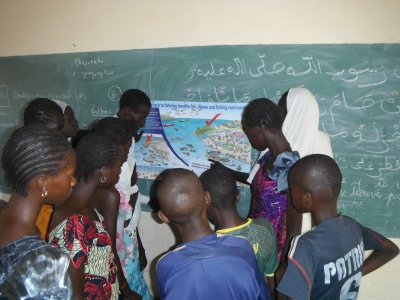
In a first step, the preparation consisted of recalling the five key principles of the EAF in class by the two teachers.
Pupils were then invited in turns to come to be blackboard to show that they had well understood the content of the posters: the EAF Nansen poster confronting two situations, one of fisheries using the ecosystem approach and another, where the approach is not complied with and the other poster showing the Senegambian ecosystem.
The programme preparations included for pupils to respond to questions the teachers had prepared in advance.
Then, in the context of time allotments available for field trips, the teachers made three excursions to visit and interact with the following players: Department of Fisheries and various associations of fishermen and fishmongers at the landing site in Hann.
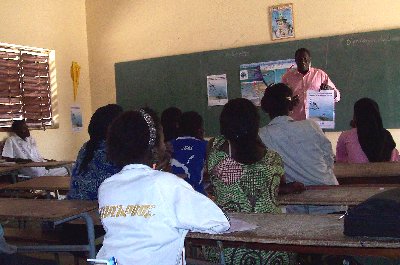
Finally, after these preparatory steps the teachers adjusted additional classroom exercises creatively to time slots allocated to different subjects: Argumentative texts in French lessons; drawings and reports by students on the basis of observations made at the end of the field visits, for example during a reporting session on the beach.
For class work, the Mountain 1 School focused on the three from among the five key principles of the EAF, namely ecosystem integrity, the precautionary approach and improving research. They focused on drawings relating to ecosystem integrity and fish measurements complemented by reports of pupils, who found a widespread disregard of minimum size limits. In addition, they worked on the problem through texts discussed in the context of French lessons and writing within the observational sciences.
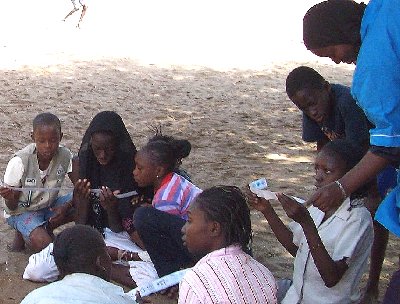
Regarding science observations, the teachers at the Mountain 1 School gave great importance to the initiation of pupils in the biology and ecology of the main fish species caught and sold in Senegal, describing also the fish ruler.
Mr. Mamadou Ndiaye, lead teacher responsible for the project, looked after the preparations by setting up the necessary contacts with the Department of Fisheries, members of the inter-professional GIE (Economic Interest Grouping) associations responsible for the exploitation of the wharf Hann and with the laboratory technicians in charge of quality control at the same landing site in Hann. It should be noted that all of these have spared no effort to help the success of field trips. The fisheries officers demonstrated unfailiing availability.
Among the activities carried out effectively during these field observations, there were (i) fish measurements, (ii) exchange sessions between pupils and staff at the Department of Fisheries in Hann, namely the person in charge of statistics, and (iii) a meeting with the associations of fishermen and fishmongers.
The constraints and opportunities

The main constraints according to Mr. Mamadou Ndiaye are: First, he deplores the short time available for the project. Time would have been sufficient under normal conditions, but with the school crisis in Senegal from October 2011 to February 2012, teachers were often obliged to organize remedial courses to reach the end of the original programme in the official curriculum. They want to invest very early in the opening of the new school year for the implementation of planned activities in their action plan.
Second, it must be negotiated with the Ministry of Education in a formalised manner to integrate the principles of the EAF in the curriculum. While the teachers can continue to do this work, which can only be appreciated by the public authorities, in an ad hoc way, but a formalization would be better. This could be done, according to Mr. Ndiaye, by a meeting between teachers in the network between Hann and Kayar one hand and authorities representing the Ministry of Education.
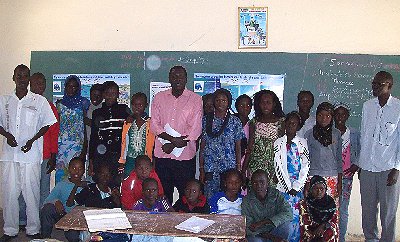
Third, he recognizes and appreciates the fact that the project has created the conditions to meet (held workshops) and assist in the implementation of classroom exercises and external observations. However, to perform all the actions included in the action plan, it will be necessary to find additional support in a context, where schools lack everything. These are real needs that require funding to support ongoing and / or planned initiatives, not budgeted anywhere. Support is required not only for stationery and photocopying, but also for a minimum of computer equipment.
Mr. Ndiaye: "We are in a school, where there is not a single computer, let alone talking about internet access for our pupils and ourselves as teachers. With the socio-cultural Centre, our pupils and ourselves had the opportunity to access the internet for a symbolic contribution, but for a long time now, this communcal cyber café is closed. We need to travel almost 3 or 4 km to find a cyber café, but the nearest ones are promiscuous and have slow connections due to the obsolescence of equipment they use. Access to minimum computer facilities is a prerequisite if we are to succeed in this project. With my fellow teachers, we must see how to address this challenge.”








